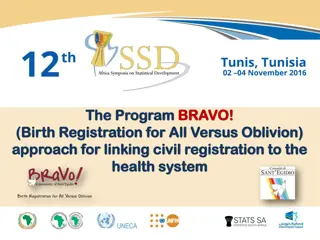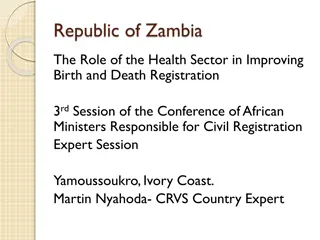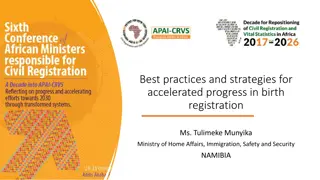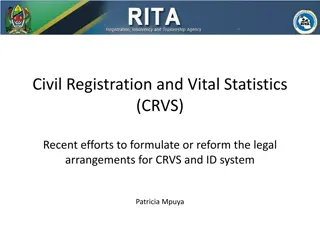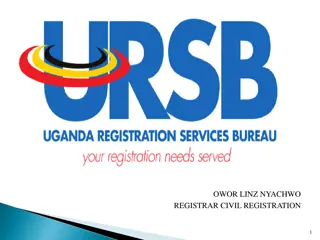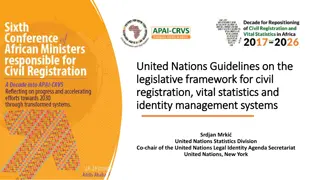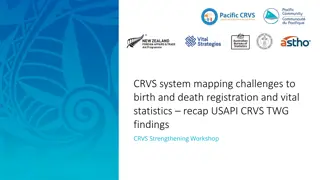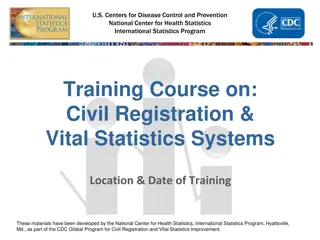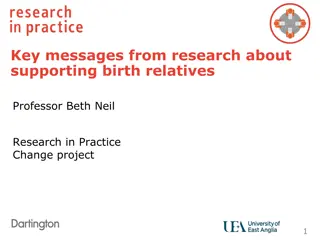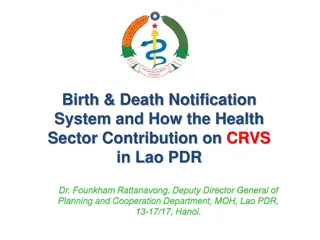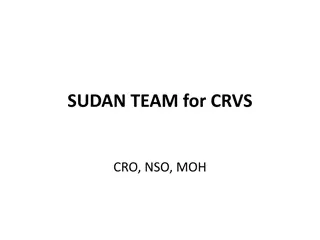Understanding Live Birth Registration in Health Statistics
Live birth registration is crucial for tracking infant mortality rates and ensuring accurate health statistics. The process involves registering all live births regardless of gestational age or the infant's survival status at the time of birth. Multiple births are registered individually if born alive, while those not born alive are recorded as fetal deaths. This data collection method is essential for public health research and policy planning.
Download Presentation

Please find below an Image/Link to download the presentation.
The content on the website is provided AS IS for your information and personal use only. It may not be sold, licensed, or shared on other websites without obtaining consent from the author. Download presentation by click this link. If you encounter any issues during the download, it is possible that the publisher has removed the file from their server.
E N D
Presentation Transcript
U.S. Centers for Disease Control and Prevention National Center for Health Statistics International Statistics Program Birth Records Birth Records These materials have been developed by the National Center for Health Statistics, International Statistics Program, Hyattsville, Md., as part of the CDC Global Program for Civil Registration and Vital Statistics Improvement.
Outline Outline Definition Information Collected Legal & administrative purposes Statistical purposes Derived data Problems with data Fetal deaths 2 Birth Records Birth Records
Definition Definition A live birth is the delivery of a child that breathes or shows signs of life regardless of the length of pregnancy. Statistical definition of Live Birth product of conception, irrespective of the duration of the pregnancy, which, after such separation, breathes or shows any other evidence of life such as beating of the heart, pulsation of the umbilical cord, or definite movement of voluntary muscles, whether or not the umbilical cord has been cut or the placenta is attached. the complete expulsion or extraction from its mother of a From International Statistical Classification of Diseases and Related Health Problems, 10th Revision, Volume 2, Instruction Manual, World Health Organization, Geneva, 1993 3 Birth Records Birth Records
Definition Definition All live births should be registered Does not depend on gestational age Does not matter if is infant alive or dead at time of registration If an infant is born alive and then dies Live birth should be registered Death should be registered An infant born alive that dies within first year is countedas an infant death (not a fetal death) for statistical purposes 4 SOURCES: International Statistical Classification of Diseases and Related Health Problems, 10th Revision, Volume 2, Instruction Manual, World Health Organization, Geneva, 1993 Birth Records Birth Records
Definition Definition If multiple pregnancy Each member born alive registered separately as live birth Members not born alive registered as fetal deaths 5 SOURCES: International Statistical Classification of Diseases and Related Health Problems, 10th Revision, Volume 2, Instruction Manual, World Health Organization, Geneva, 1993 Birth Records Birth Records
Birth Information that could be Collected for Legal and Administrative Use Birth Information that could be Collected for Legal and Administrative Use Date of birth Time of birth Place of birth Full name of child Sex of child Type of birth Mother s name Father s name Marital status of mother Other information about mother Date of birth or age Place of birth or nationality Names of mother s parents Identification number Other information about father Date of birth or age Place of birth or nationality Names of father s parents Identification number Place of residence of mother or family Duration at residence Type of place of birth Attendant at birth Name Type (physician, midwife, nurse, etc.) Address License number Date of registration Place of registration Name and relationship of informant Attestation statement with signature of attendant, informant or registrar Birth registration number 6 SOURCES: Principles and Recommendations for a Vital Statistics System, Revision 2, United Nations, New York, 2001, Chapter II Birth Records Birth Records
Birth Information that could be Collected for Statistical Purposes Birth Information that could be Collected for Statistical Purposes Characteristics of the father Educational level Occupation Ethnicity, race or religion Characteristics of the mother Educational level Occupation Ethnicity, race or religion Medical information related to birth Birth weight of child Length of gestation Number of previous children born alive to mother Number of fetal deaths (or stillborn children) of mother When medical care began Number of prenatal visits Other medical information on mother Date of last previous live birth (or interval since last live birth) Weight prior to pregnancy and weight at delivery Medical conditions that may cause problems during pregnancy Method of delivery Other complications of delivery or pregnancy Crown-heel length of infant at delivery Abnormal conditions of the infant Congenital anomalies 7 SOURCES: Principles and Recommendations for a Vital Statistics System, Revision 2, United Nations, New York, 2001, Chapter II (also following slide, Birth Information Collected Derived Data ) Birth Records Birth Records
Birth Information Collected Birth Information Collected Derived Data ( (Items for statistical purposes not collected directly on birth record but derived from those items and added to computer files for tabulation) Derived Data Derived Data Item Age of mother and father Live birth order Socio-economic indicator Detail on residence such as urban, rural, regional, etc. Other geographic groupings Weight gained by mother during pregnancy Trimester care began Adequacy of prenatal care Birth weight categories Low birth weight Very low birth weight Source on Birth Record Date of birth for mother and father Previous births plus this birth Education and/or occupation City, town or address of mother s residence Residence of mother or place of birth Weight prior to birth and weight at delivery Month care began or date of first visit Number of visits and date of first visit Birth weight Weight less than 2500 grams Weight less than 1500 grams Weight less than 1000 grams 8 Birth Records Birth Records Extremely low birth weight
Information Collected Information Collected Samples of birth records from various countries should be shown to the students particularly those for the countries the students are from. Examples should include birth records for countries that collect different types of medical information to show what different countries might analyze on natality and pregnancy. 9 Birth Records Birth Records
Activity Activity In small groups examine birth certificates for various countries. Compare your country s birth record with those from other countries looking at the following: What items do birth records from other countries have that their country s record does not have (missing items)? What kinds of public health analyses can be done with these missing items? Are any of the missing items useful for administrative or other purposes? Do you think that some items used in other countries should be added to your country s birth record, and if so, why? 10 Birth Records Birth Records
Problems with Birth Data Problems with Birth Data Problem Source and Accuracy of Information Examples Informant does not know correct information Mother does not recall her medical care information Sensitive information not given correctly Birth records not registered in some geographic areas or for some population groups Late records not included in statistical files Records for low weight infants or those who die are known to be poorly registered Missing Records Missing Information Medical items often left blank Data skewed due to missing items for some population groups Transcription errors when data entered in record Coding errors Keying errors Errors in computer software programs Statistical information not correctly linked to legal information when separate collection systems used Errors in Preparation and Processing 11 SOURCES: Principles and Recommendations for a Vital Statistics System, Revision 2, United Nations, New York, 2001, Chapter II Birth Records Birth Records
Discuss Discuss What are some problems with birth records? What effect can these problems have on statistical data? What are some possible ways to prevent these problems? 12 Birth Records Birth Records
Review Review Births records should be registered for all infants born alive Regardless of gestational age Even if infant dead at time of registration If infant born alive and then dies Both live birth and death should be registered For a multiple pregnancy Each member born alive registered separately as a live birth Any members not born alive registered as fetal deaths 13 Birth Records Birth Records
Review Review Information on birth records Collected for legal, administrative and statistical purposes Items can be added to computer files for tabulation and analysis of data Problems with birth data include Source and accuracy of information Missing records Missing information Errors in preparation and processing 14 Birth Records Birth Records
Fetal Deaths Fetal Deaths A fetal death is the delivery of a fetus that does not breathe or show any signs of life regardless of the length of pregnancy. Statistical definition of Fetal Death product of conception, irrespective of the duration of pregnancy; the death is indicated by the fact that after such separation the fetus does not breathe or show any other evidence of life, such as beating of the heart, pulsation of the umbilical cord or definite movement of voluntary muscles. the complete expulsion or extraction from its mother of a 15 SOURCES: International Statistical Classification of Diseases and Related Health Problems, 10th Revision, Volume 2, Instruction Manual, World Health Organization, Geneva, 1993 Birth Records Birth Records
Fetal Deaths Fetal Deaths Registration requirements Not required in all countries Usually only late fetal deaths WHO recommendations for reporting Fetuses weighing at least 500 grams at delivery If weight not available 22 completed weeks of gestational age Or crown-heel length of 25 centimeters 16 SOURCES: International Statistical Classification of Diseases and Related Health Problems, 10th Revision, Volume 2, Instruction Manual, World Health Organization, Geneva, 1993 Birth Records Birth Records
Fetal Deaths Fetal Deaths Information collected Usually same as birth information where appropriate Possibly cause of fetal death Not well reported even in developed countries Data Usually combined with birth information Study conditions related to pregnancy Fertility patterns 17 SOURCES: Principles and Recommendations for a Vital Statistics System, Revision 2, United Nations, New York, 2001, Chapter II Birth Records Birth Records
Fetal Deaths Fetal Deaths Accuracy of fetal/infant death reporting Challenging part of a CR/VS system, particularly for deaths close to birth Infant deaths may be reported as fetal deaths Easier to process emotionally Funeral expenses reduced 18 Birth Records Birth Records
Fetal Deaths Fetal Deaths If fetal deaths are included, a slide should show what fetal deaths are required to be reported and what information is collected in the country where the course is being taught. 19 Birth Records Birth Records
Review Review A fetal death is the delivery of a fetus that does not breathe or show any signs of life regardless of the length of the pregnancy. WHO recommends reporting of fetal deaths weighing 500 grams or more All fetal deaths meeting minimum reporting requirements should be registered Any members of a multiple pregnancy not born alive should be registered as fetal deaths Data from fetal deaths are usually combined with data from birth records to study conditions of pregnancy 20 Birth Records Birth Records
Word Choice Questions Word Choice Questions 1. If an infant is born alive and dies within the first day, a birth record (should/should not) be registered. Items not needed for legal purposes (may/may not) be added to birth records to obtain statistical information. For purposes of statistical tabulation, items may be derived from information on the birth record and added to the (certified copy/computer file). Coding and keying of items on birth records (may/may not) be a source of errors in computerization of birth records. The delivery of a fetus that does not breathe or show any signs of life regardless of the length of the pregnancy should be reported as a (infant/fetal) death. 2. 3. 4. 5. 21 Birth Records Birth Records


